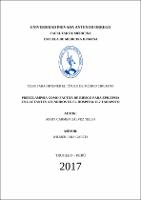Mostrar el registro sencillo del ítem
Preclampsia como factor de riesgo para epilepsia en lactantes atendidos en el Hospital II 2 Tarapoto
| dc.contributor.advisor | Jara Garcia Wilmer | |
| dc.contributor.author | Galvez Tello, Mary Carmen | |
| dc.creator | Galvez Tello, Mary Carmen | |
| dc.date.accessioned | 2017-05-29T21:30:11Z | |
| dc.date.available | 2017-05-29T21:30:11Z | |
| dc.date.issued | 2017 | |
| dc.identifier.uri | https://hdl.handle.net/20.500.12759/2722 | |
| dc.description.abstract | OBJETIVO: Determinar si la preeclampsia es un factor de riesgo para epilepsia en lactantes. MATERIAL Y MÉTODO: Se realizó un estudio retrospectivo, observacional, analítico, de casos y controles en el Hospital II-2 Tarapoto en el periodo 2014 – 2016; se evaluaron 320 historias clínicas de lactantes, 80 con el diagnóstico de epilepsia y 240 sin el diagnóstico de epilepsia. Se utilizó la prueba estadística chi cuadrado y se calculó el Odds ratio. RESULTADOS: Se encontró que de los lactantes con diagnóstico de epilepsia, el 33.75% fueron de madres con preeclampsia, así mismo de los lactantes que no son epilépticos el 12.08% tuvieron madres con preeclampsia. Se determinó que existe asociación significativamente estadística entre las dos variables de estudio con un p = 0.0000 (p= < 0.05). Además se halló un OR de 3.71, que indicó que las madres con preeclampsia fueron 3.71 veces más frecuentes en lactantes con epilepsia que en los lactantes no epilépticos; entonces la preeclampsia se convierte en un factor de riesgo. Se encontró un intervalo de confianza de OR del 95% de los casos tienen de 2.03 a 6.78. CONCLUSIONES: Existe relación significativa entre preeclampsia y epilepsia en lactantes, siendo la preeclampsia un factor de riesgo para epilepsia. | es_PE |
| dc.description.abstract | OBJECTIVE: To determine if preeclampsia is a risk factor for epilepsy in infants. MATERIAL AND METHOD: A retrospective, observational, analytical study of cases and controls was performed at Hospital II-2 Tarapoto in the period 2014-2016; 320 clinical histories of infants were evaluated, 80 with the diagnosis of epilepsy and 240 without the diagnosis of epilepsy. The chi-square statistical test was used and the odds ratio was calculated. RESULTS: Of the infants diagnosed with epilepsy, 33.75% were mothers with preeclampsia, and 12.08% of infants who were not epileptics had preeclampsia. It was determined that there is a statistical association between the two study variables with p = 0.0000 (p = <0.05). In addition, an OR of 3.71 was found, indicating that mothers with preeclampsia were 3.71 times more frequent in infants with epilepsy than in non-epileptic infants; Preeclampsia becomes a risk factor. An OR confidence interval of 95% of cases was found to be from 2.03 to 6.78. CONCLUSIONS: There is a significant relationship between preeclampsia and epilepsy in infants, with preeclampsia being a risk factor for epilepsy. | en_US |
| dc.description.uri | Tesis | es_PE |
| dc.format | application/pdf | es_PE |
| dc.language.iso | spa | es_PE |
| dc.publisher | Universidad Privada Antenor Orrego - UPAO | es_PE |
| dc.relation.ispartofseries | T_MED.HUMA_2136 | |
| dc.rights | info:eu-repo/semantics/openAccess | es_PE |
| dc.source | Universidad Privada Antenor Orrego | es_PE |
| dc.source | Repositorio Institucional - UPAO | es_PE |
| dc.subject | Preeclampsia | es_PE |
| dc.subject | Epilepsia | es_PE |
| dc.title | Preclampsia como factor de riesgo para epilepsia en lactantes atendidos en el Hospital II 2 Tarapoto | es_PE |
| dc.type | info:eu-repo/semantics/bachelorThesis | es_PE |
| thesis.degree.level | Título Profesional | es_PE |
| thesis.degree.grantor | Universidad Privada Antenor Orrego. Facultad de Medicina Humana | es_PE |
| thesis.degree.name | Médico Cirujano | es_PE |
| thesis.degree.discipline | Medicina Humana | es_PE |
Ficheros en el ítem
Este ítem aparece en la(s) siguiente(s) colección(es)
-
Medicina Humana [2739]

